Sublimation in Psychology: Turn Negative Impulses Into Positive Action
Sublimation is a powerful tool for managing emotions and impulses. By developing self-awareness and finding positive outlets, you can transform challenges into constructive actions.
What Is Sublimation Psychology?
Sublimation is a psychological defense mechanism where individuals channel unacceptable impulses into socially acceptable behaviors. For example, someone with aggressive tendencies might take up a sport like boxing to express those urges constructively.
Origin of the Concept
Sigmund Freud introduced sublimation within his psychoanalytic theory. He proposed that the human psyche is made up of three components: the id, ego, and superego. The id harbors primal urges, while the superego imposes moral standards.
The ego serves as the intermediary between these forces, and sublimation is utilized as a method to turn prohibited desires into actions that comply with social norms.

Key Features:
The ability of the mind to adapt and find constructive outlets for deep-seated impulses is highlighted by understanding sublimation.
- Transformation of Impulses: Redirecting unacceptable desires into positive activities.
- Social Acceptance: Engaging in behaviors that are valued by society.
- Long-Term Adaptation: Facilitating personal growth and cultural contributions.
4 Types of Sublimation in Psychology
Sublimation manifests in distinct ways depending on the impulse and outlet:
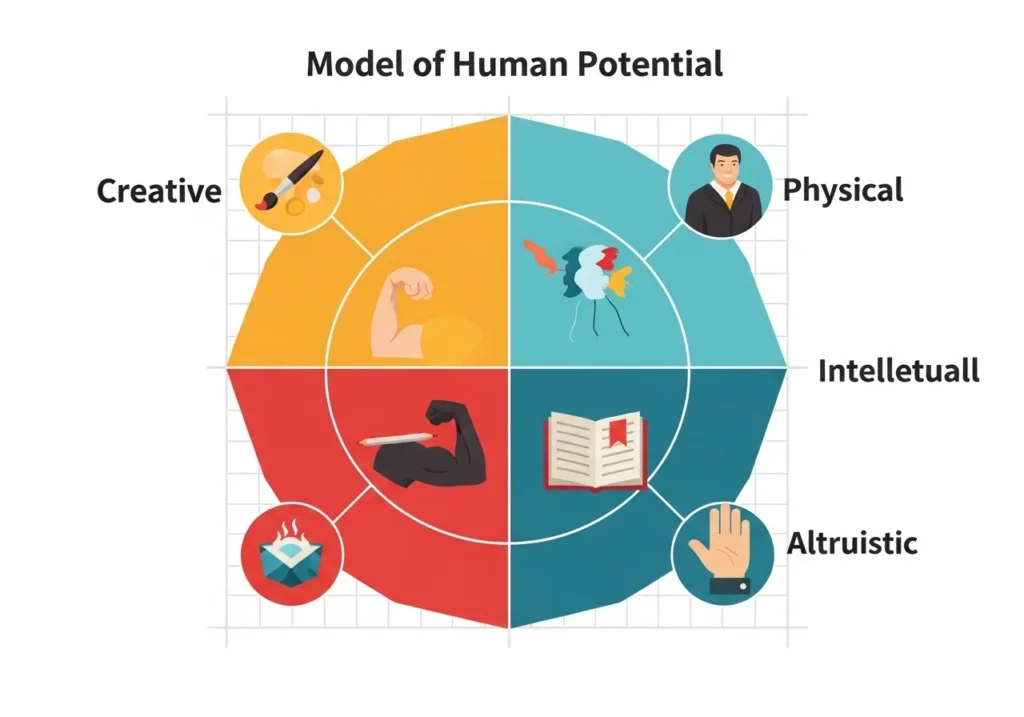
- Creative Sublimation
- Impulse: Emotional turmoil, sexual energy, or anxiety.
- Outlet: Painting, writing, composing music.
- Example: Frida Kahlo channeling physical pain into surrealist art.
- Physical Sublimation
- Impulse: Aggression, restlessness.
- Outlet: Boxing, running, woodworking.
- Example: A combat veteran becoming a martial arts instructor.
- Intellectual Sublimation
- Impulse: Obsessive thoughts, perfectionism.
- Outlet: Research, coding, philosophical debates.
- Example: A detail-obsessed lawyer excelling in forensic analysis.
- Altruistic Sublimation
- Impulse: Grief, guilt, loneliness.
- Outlet: Volunteering, mentoring, activism.
- Example: A bereaved parent starting a support group.
Hybrid Case:
A perfectionist (intellectual) becomes a master carpenter (physical), merging two sublimation types.
Freud’s Role in Defining Sublimation
Sigmund Freud‘s psychodynamic theory offers a framework for understanding human behavior through the interplay of three core components: the id, the ego, and the superego. These elements interact to shape our personalities and influence our actions.
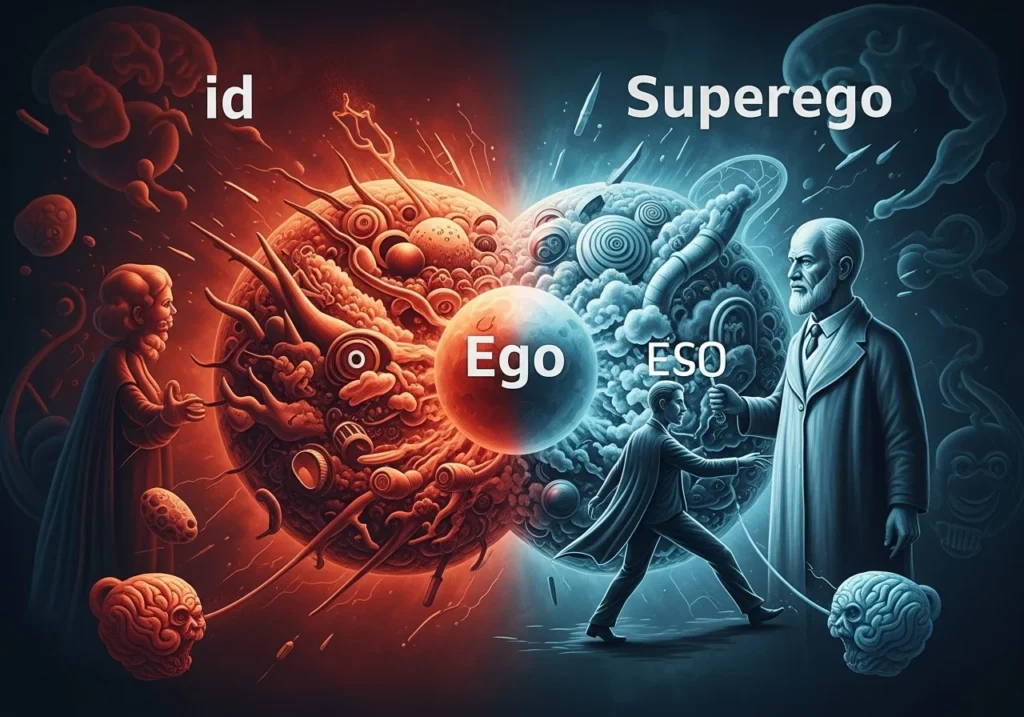
Id, Ego, and Superego in Sublimation
The ego channeled the id’s unacceptable urges into behaviors that conform to the superego’s moral standards during sublimation, transforming potentially disruptive impulses into positive, constructive actions.

- Id: Represents innate, primal desires seeking immediate gratification, operating on the pleasure principle.
- Ego: Mediates between the id’s impulses and reality, functioning on the reality principle to find socially acceptable ways to satisfy desires.
- Superego: Embodies moral standards and ideals internalized from society and parents, guiding judgments about right and wrong.
🧠 Sublimation vs. Repression vs. Suppression
Understanding these distinctions shows how sublimation is a mature defense mechanism that allows individuals to navigate complex emotions by redirecting them into beneficial pursuits.
⏳ Repression
An unconscious mechanism where distressing thoughts are pushed out of awareness.
✋ Suppression
A conscious effort to avoid certain thoughts or impulses.
✨ Sublimation
Transforms impulses into productive and socially acceptable activities.
| Mechanism | Conscious? | What It Does | End Result |
|---|---|---|---|
| Repression | Unconscious | Pushes urges deep below awareness | Emotional build-up |
| Suppression | Conscious | Deliberate effort to ignore urges | Temporary relief |
| Sublimation | Often unconscious | Converts urges into creative action | Productive outcomes |
Repression hides. Suppression delays. Sublimation transforms. 🔄
Reaction Formation Explained:
A defense mechanism where you express the opposite of your true feelings:
- Example: Acting overly kind to someone you dislike.
- Key Difference from Sublimation:
- Reaction formation masks emotions (unhealthy).
- Sublimation repurposes them (healthy).
How Sublimation Works in the Brain
Sublimation, a defense mechanism where individuals channel unacceptable impulses into socially acceptable behaviors, involves intricate brain processes. Understanding these processes sheds light on how we transform internal drives into constructive actions.
1. Impulse Redirection and Dopamine Release
When we redirect impulses through sublimation, the brain’s reward system becomes active. This system involves dopamine, a neurotransmitter linked to pleasure and motivation.
Activities like engaging in creative arts or sports not only serve as outlets for these impulses but also trigger dopamine release, reinforcing the behavior. This release provides a sense of satisfaction, making the constructive activity more appealing and encouraging its repetition.

2. Neurobiology of Self-Control
These regions work together to suppress immediate, potentially harmful impulses, allowing for thoughtful decision-making and the adoption of behaviors that align with societal norms. Self-control relies heavily on specific brain regions responsible for regulating behavior and emotions. Key areas include:
- Prefrontal Cortex (PFC): Essential for decision-making and moderating social behavior.
- Orbitofrontal Cortex (OFC): Involved in evaluating rewards and punishments, aiding in assessing the consequences of actions.
- Anterior Cingulate Cortex (ACC): Plays a role in error detection and emotional regulation.

3. Connection to Behavior Patterns
By understanding the brain’s role in sublimation, we gain insight into how our internal drives shape our behaviors and how we can harness this knowledge to promote positive change. The brain’s ability to redirect impulses through sublimation influences behavior patterns in several ways:
- Learning and Habit Formation: Consistently engaging in sublimated activities strengthens neural pathways, making these behaviors more automatic over time.
- Emotional Regulation: Successfully channeling impulses can lead to better emotional control, reducing stress and enhancing overall well-being.
- Social Integration: Participating in socially acceptable activities fosters positive interactions, reinforcing a sense of belonging and acceptance.

Sublimation vs. Other Defense Mechanisms
Defense mechanisms are psychological strategies employed to cope with internal conflicts and external stressors. Among these, sublimation stands out for its adaptive qualities.
🛡️ Defense Mechanisms Compared
💡 Key Insight: While all defense mechanisms serve psychological protection, sublimation uniquely transforms energy into socially beneficial outcomes.
Displacement vs. Sublimation: Key Differences

While both redirect emotions:
- Displacement: Shifts feelings onto a safer target (e.g., yelling at your spouse after a bad workday).
- Unconscious, often harmful.
- Sublimation: Transforms the emotion into a productive activity (e.g., working out post-anger).
- Adaptive, socially beneficial.
Example:
- Displacement: Kicking a chair when frustrated with your boss.
- Sublimation: Channeling frustration into a woodworking project.
✓ Why Sublimation Is Adaptive
The transformation of potentially harmful impulses into beneficial outcomes makes sublimation a mature defense mechanism. By redirecting energy toward positive endeavors, individuals:
- Effectively manage difficult emotions
- Achieve personal growth and fulfillment
- Make valuable contributions to society
🌱 Healthy Outcome: Creates win-win situations for both individual and society
! When It Becomes Unhealthy
While generally positive, sublimation can become problematic when:
- Used excessively without addressing root causes
- Substituted activities become compulsive/harmful
- Leads to avoidance of direct emotional processing
⚠️ Warning Sign: When “healthy” outlets cause harm (e.g., exercise injuries from overtraining)
⚖️ Key Balance: Sublimation works best when combined with self-awareness and emotional processing
Rationalization Psychology: When Excuses Replace Growth
Rationalization is a defense mechanism where we invent logical-but-false explanations for behaviors or feelings:
Key Characteristics:
- Creates “good reasons” for poor choices
- Protects self-esteem temporarily
- Prevents genuine self-reflection
Examples:
- “I only cheat on my diet because healthy food is expensive”
- “I failed the test because the teacher doesn’t like me”
How It Differs From Sublimation:
| Mechanism | Process | Outcome |
|---|---|---|
| Rationalization | Inventing excuses | Stagnation |
| Sublimation | Transforming energy | Growth |
Psychological Impact:
While sublimation channels energy productively, rationalization traps us in cycles of self-deception that hinder personal development.
Projection Psychology: Blaming Others for Your Traits
Projection attributes your unacceptable feelings to others:
- Example:
- Accusing your partner of flirting when you feel attracted to someone.
Why Sublimation Is Healthier:
- Projection distorts reality; sublimation aligns impulses with values.
Regression Psychology: Retreating to Childlike Behaviors
Under stress, people revert to earlier developmental stages:
- Examples:
- An adult throwing tantrums during arguments.
- A child sucking their thumb after a new sibling’s birth.
Sublimation as the Antidote:
- Regression is escapism; sublimation is proactive coping.
Fundamental Attribution Error: Why We Misjudge Others
This cognitive bias makes us:
- Blame personality for others’ mistakes (e.g., “They’re lazy”).
- Blame circumstances for our own (e.g., “I was tired”).
Link to Sublimation:
Understanding this error fosters empathy, creating space to sublimate judgment into curiosity (e.g., “What’s their story?”).
Repression vs. Sublimation:
| Aspect | Repression | Sublimation |
|---|---|---|
| Conscious? | Unconscious | Often unconscious |
| Outcome | Emotional buildup | Productive action |
| Health | Leads to anxiety | Promotes growth |
Freudian Insight: Repression fuels neuroses; sublimation fuels culture.
Common Examples of Sublimation in Everyday Life
Sublimation helps people direct strong emotions into healthier actions that support personal growth. Here are a few everyday examples that show how this works.
Anger redirected into exercise or activism
Turning frustration into productive movement or community involvement changes aggressive energy into something constructive.
Intense urges redirected into creative work
Channeling emotional or physical tension into art, writing, or music leads to meaningful creative output.
Sadness directed toward helping others
Supporting people who are struggling creates connection and helps ease personal grief.
Ambition focused on career or skill building
Using competitive energy to hit goals or improve abilities turns drive into long term progress.
Grief expressed through writing or art
Turning loss into creative work provides a healthy outlet and helps make sense of difficult emotions.
Sublimation helps turn emotional challenges into productive and meaningful action.
The Role of Sublimation in Mental Health
Individuals can transform undesirable impulses into positive actions using sublimation, which plays a pivotal role in mental health and fosters emotional well-being and personal growth.
Healthy Emotional Expression
Intense emotions like anger or frustration can be channeled into constructive outlets, like sports, creating art, or pursuing demanding careers, which can help individuals express their feelings in a healthy way. Not only does this process ease internal tension, it also contributes to personal development and societal enrichment.
Its Use in CBT and Psychoanalytic Therapy
Therapists in cognitive-behavioral therapy (CBT) help clients identify negative thought patterns and encourage them to adopt healthier coping mechanisms, such as sublimation. Effective stress management and anxiety reduction can be achieved by recognizing and redirecting maladaptive impulses towards positive behaviors.
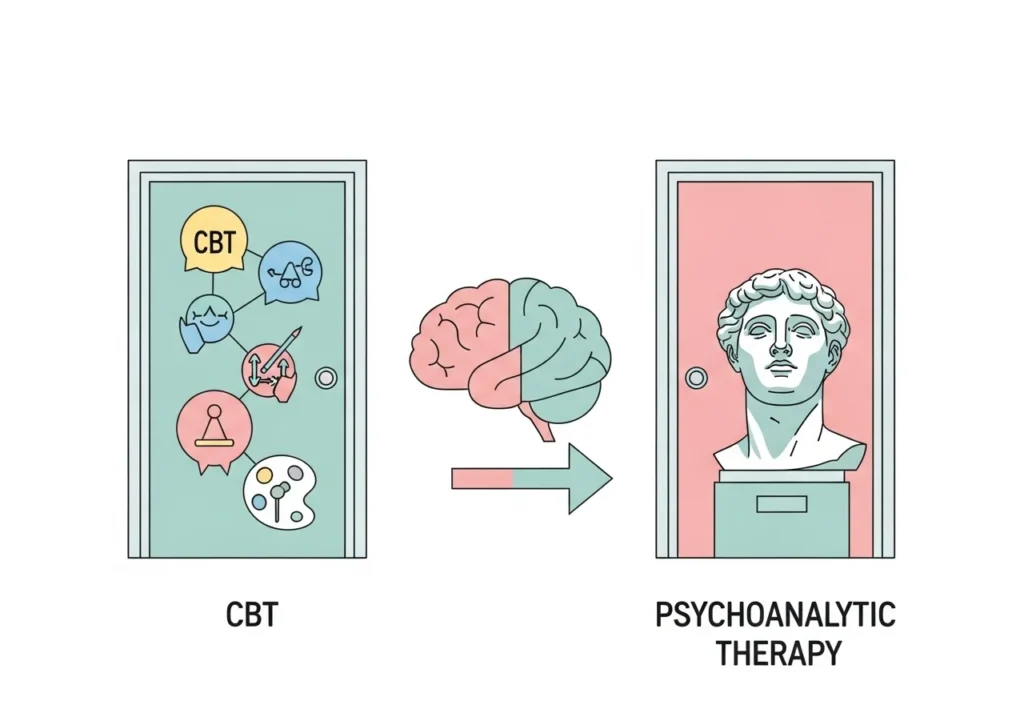
Sublimation is emphasized in psychoanalytic therapy as a mature defense mechanism. Therapists work with individuals to uncover unconscious drives and guide them towards transforming these urges into socially acceptable and beneficial activities.
Recognizing Sublimation in Behavior Patterns
To identify, it is important to observe instances where negative emotions or impulses are diverted into productive endeavors. For example, a person who channels aggressive tendencies into competitive sports or expresses complex emotions through artistic creation demonstrates sublimation.
Acknowledging these patterns can improve self-awareness and encourage healthier emotional regulation strategies.
Can You Practice Sublimation on Purpose?
Conscientiously redirecting undesirable impulses into positive, constructive actions is what sublimation is, a psychological defense mechanism. Individuals can effectively manage emotions and foster personal growth by intentionally practicing sublimation.
Identifying the Impulse
Start by recognizing the specific impulse or emotion you want to redirect. This could be anger, frustration, or other intense emotions. Understanding the nature of these impulses and their triggers requires self-awareness.
Choosing Positive Outlets
Choosing an outlet that aligns with your interests can lead to sustained engagement. Once the impulse is identified, select an appropriate and constructive outlet:
- Physical Activities: Engaging in sports or exercise can help channel aggressive energies.
- Creative Arts: Pursuing activities like painting, writing, or playing music allows for emotional expression
- Community Service: Volunteering provides a sense of purpose and redirects focus from personal distress.
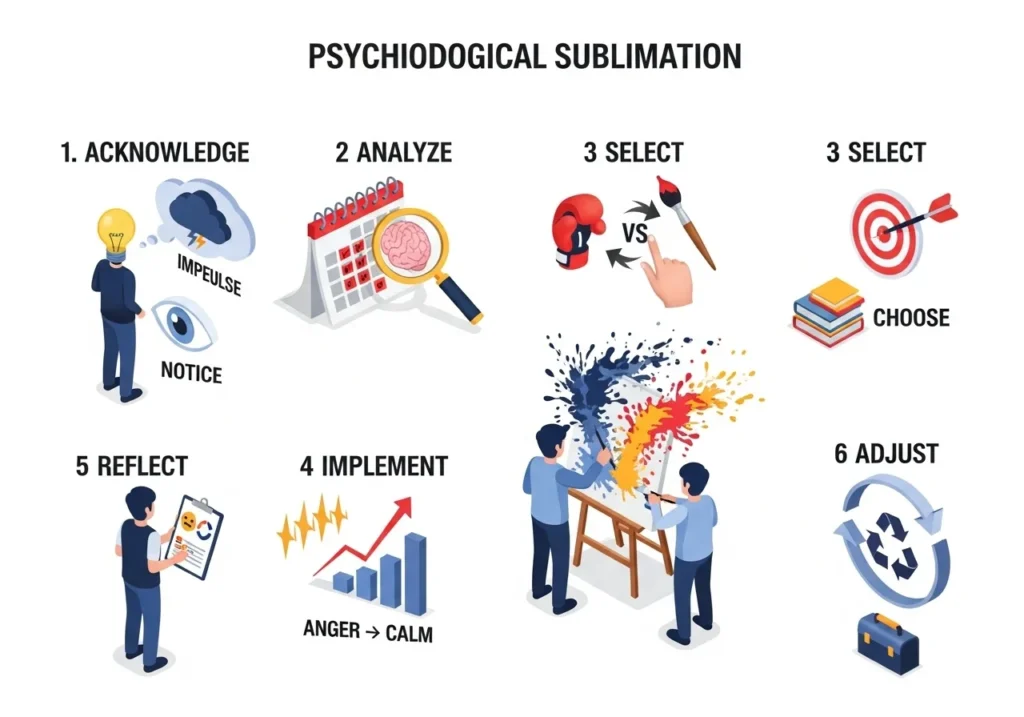
Step-by-Step Guide
- Acknowledge the Impulse: Accept the presence of the impulse without judgment.
- Analyze Triggers: Identify situations or thoughts that provoke the impulse.
- Select an Alternative Activity: Choose a constructive behavior to replace the undesirable action.
- Implement the Activity: Engage in the chosen activity when the impulse arises.
- Reflect on Outcomes: Assess how the new activity affects your emotions and impulse control.
- Adjust as Needed: Modify your approach based on effectiveness and personal comfort.
Tips for Building Habits
Developing the habit of sublimation requires consistency and patience:
- Set Clear Goals: Define what you aim to achieve through sublimation.
- Create Reminders: Use cues to prompt engagement in positive outlets.
- Seek Support: Share your objectives with friends or therapists who can offer encouragement
- Monitor Progress: Keep a journal to track triggers, responses, and emotional changes.
- Be Patient: Understand that habit formation takes time and persistence.
Risks, Misunderstandings, & Limits of Sublimation
Sublimation’s a cool tool for handling tough emotions, but it’s not perfect. Let’s break down its quirks!
When Sublimation Turns Into Avoidance
Using sublimation to dodge unwanted vibes? It might backfire. Constantly redirecting emotions without digging into the why can leave unresolved stuff simmering beneath the surface.
Over-Intellectualization & Emotional Drift
Leaning too hard on logic to skip the feels? You might end up emotionally detached. This can block real emotional flow and leave you out of touch with your inner self.
Modern Psychology Weighs In
Today’s experts say sublimation’s great, but don’t overdo it. Ignoring core emotions? Not cool. A mix of coping and facing feelings head-on is the sweet spot.
Getting the full picture of sublimation helps you wield it like a pro while dodging its traps. Balance is your superpower.
Sublimation in Culture and Society
The transformation of primal impulses into constructive behaviors has profoundly shaped religion, history, and modern culture. This powerful psychological process turns personal challenges into societal contributions.
Religion and Spiritual Discipline
Sacred traditions worldwide harness sublimation through practices like celibacy and fasting. Monastic communities transform personal desires into devotion, creating centers of spiritual growth and service that strengthen communal bonds.
Historical Transformations
Monastic Scholars: Medieval monks redirected personal energies into preserving knowledge through meticulous manuscript transcription, advancing civilization.
Renaissance Masters: Da Vinci and Michelangelo transformed inner turmoil into timeless art that continues to shape cultural expression.
Social Reformers: Figures like MLK Jr. channeled experiences of injustice into nonviolent movements that transformed societies.
Modern Cultural Icons
Contemporary figures continue this transformative tradition:
- Edith Kramer pioneered art therapy, turning creative energy into healing practices
- Elite athletes convert personal struggles into record-breaking performances
- Musicians and writers transform emotional pain into works that resonate globally
From monasteries to museums, sublimation turns human impulses into cultural treasures.
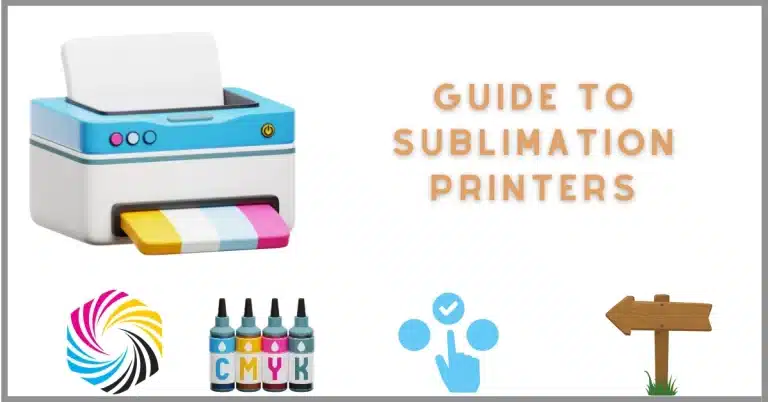




2 Comments